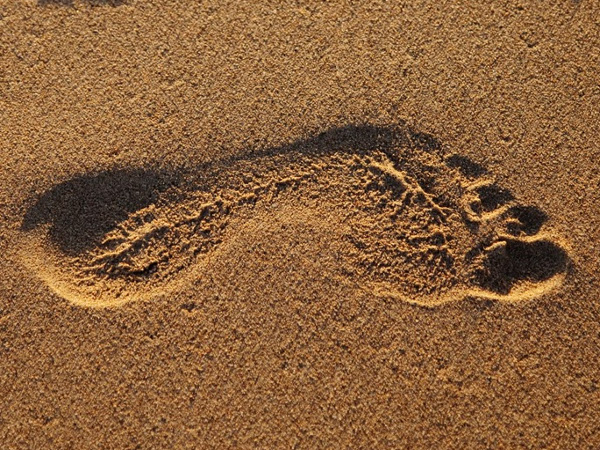Eco & carbon footprints - introduction

“The ecological footprint measures how fast we consume resources and generate waste compared to how fast nature can absorb our waste and generate new resources.” – Global Footprint Network
Contents
What are eco & carbon footprints?
They’re tools to help calculate the impact that humans are having on nature. They can give us a rough idea as to whether our way of life is sustainable or not.
The ‘footprint’ of an individual, community, country or the whole of humanity is expressed as the land area required to provide the resources and absorb the wastes involved in sustaining them. This is measured in ‘global hectares’. For ease of understanding, this can be translated into the number of planets that would be required for everyone to live that way.

For example, as an individual, if calculations show that I have a ‘2-planet’ footprint, it means that if everyone in the world lived like me, it would require two Planet Earths to support us all. As we only have one Earth, the footprint of the human species obviously has to be less than one planet, or we will degrade this one until it won’t support us any more.
For a more detailed explanation of the concept of eco footprint, see this booklet produced by Radical Routes and Keveral Farm.
Humanity’s footprint represents our demands on the Earth versus its ability to supply what we need. This ability is known as biological capacity or ‘biocapacity’ (see below).
Biocapacity
The biocapacity of a nation or a region is the total productivity of all its ecological assets (cropland, grazing land, forest land, fishing grounds, built-up land, etc.). As well as providing resources, these areas, especially if left unharvested, also absorb much of the pollution we create, especially carbon emissions. Obviously not all countries are equal – some have lots of rainforest but little arable land, while others have a lot of desert and not much else – so the biocapacity of a particular country is calculated as an average, as if all hectares on the Earth’s surface were equally productive. Biocapacity can be increased or decreased by increasing or decreasing useful land area, changing the way we manage it; but also consumption and/or population. Biocapacity (as calculated by the Global Footprint Network and based on UN data for some 150 nations) doesn’t include data on soil depletion or the ability of the oceans to absorb carbon dioxide or plastic pollution (oceans lie outside national boundaries). So it may be that the Earth’s biocapacity and our ecological footprint are actually underestimated.
An ecological footprint differs from a carbon footprint in that the latter is a measure of greenhouse gas production, while the former is concerned with the total impact of our activities. Therefore, your ecological footprint includes your carbon footprint, along with other measures of natural resource use (water, soil, energy, food, fibre, timber, minerals, etc.) and waste. Your carbon footprint is almost entirely down to the amount of fossil fuels you are responsible for burning (plus a component linked to the amount of biomass you are responsible for removing), to provide your consumption and deal with your waste.
History
The term ‘ecological footprint’ was coined in the early ’90s by Mathis Wackernagel and William Rees at the University of British Columbia, who founded the Global Footprint Network. The concept was later used by the Worldwide Fund for Nature (WWF) in their ‘Best Foot Forward’ campaign and continues to be used today by scientists, businesses, governments, individuals and institutions that monitor our use of ecological resources and work towards sustainable development. [NB: WWF have now distanced themselves from the ecological footprint measurement and concentrate more on carbon footprints, which are easier to measure and better understood by the public. They also recommend using a basket of indicators, such as those provided by the UN System of Environmental and Economic Accounting, and Sustainable Development Goals.]

The ecological footprint of an individual, community or nation is calculated as Population x Consumption ÷ Biocapacity. With a population of 7.6 billion in early 2018, humanity as a whole is currently exceeding the planet’s biocapacity by a factor of 1.7. That means we’re using 1.7 times more ecological resources than nature can regenerate in a year, for example by emitting more carbon dioxide into the atmosphere than forests can absorb.
Put another way, the eco footprint of humanity is now 1.7 planets – so we’re using 1.7 planet’s worth of stuff when we’ve only got one. But that’s a global average. Some people (in most of Africa, for example) consume very little, while others use a lot more than their fair share. In the UK we’re guzzling our way through 3.5 planets worth of stuff every year, and in the US and Australia, it’s nearer 5. It’s clear than not everyone can achieve a Western standard of living.
We passed the global Earth Overshoot mark – the point at which we exceeded the planet’s biocapacity – in the 1980s, and our ecological footprint has continued to grow steadily ever since. The main drivers are population growth and over-consumption. Global population is predicted to be 10-11 billion by the end of the century, around 80% of whom will be living in cities. Certain parts of the world are also seeing a rise in the middle-classes, with increased wealth and disposable income, so consumption has increased there too. In the space of one generation, China has gone from almost no-one owning ‘luxury’ goods like fridges and cars to almost everyone owning them. There’s also been a rise in the numbers of the global super-rich – and they spend a lot.
What are the benefits of eco & carbon footprints?
They make it very clear whether the way we live is sustainable or not. Lowimpact.org is all about reducing our impact on nature – but before the ‘footprint’ concept was developed, it was very difficult to work out what our individual or collective impact actually was.
Although the eco / carbon footprint concept is a bit of a blunt instrument, and can only be a rough guide, it does have the advantage of allowing us to visualize the impact of overall human demand on nature versus what nature can cope with.
Calculating your personal footprint allows you to see where you’re exceeding ‘one-planet’, and to identify areas of action to reduce your consumption, and therefore impact. It gives you a target to aim for (a one-planet footprint). The same thing works for countries and communities of any size.
There are educational benefits too. Teaching about ecological footprints in schools allows children to make the connection between daily life and global sustainability.

Compare the images – 2018 and 2022.

What can I do?
In a nutshell, make sure that your footprint is less than one planet.
To see how you’re doing, calculate your personal ecological footprint. You can use one these established online calculators:
“Eco footprint calculators provide only rough estimates. For example, I could have 15 children, but procreation isn’t mentioned; I could be a billionaire and spend a million pounds per week, but overall consumption isn’t covered. The Global Footprint Network gave me a footprint of 0.9 planets. I was happy, because it indicated that everyone in the world could have my impact on nature and we’d be fine. But as I said, it didn’t take everything into consideration, and I’m unusual – I hardly buy anything, don’t have a car and don’t fly. I did the test again and added 20 hours flying, and my score grew more than 50% to 1.4 planets – i.e. not sustainable. The second calculator was more detailed, and asked more questions about consumption. I scored 91% on this one, expressed as a percentage of the UK target. I guess the UK target has to be one planet, so 91% is the same as 0.9 planets – so there’s consistency between tests.” – Dave Darby
There are other footprint calculators too – search online. Here’s a more detailed calculator, with guidance notes, commissioned by the Welsh Government and used by Lammas Community, a One-Planet Development in Pembrokeshire; and here’s a carbon calculator from the National Energy Foundation.
The Global Footprint Network’s interactive map allows you to see a country’s footprint, and manipulate different variables to see how it could change. However, they state that: ‘An ecological deficit occurs when the Ecological Footprint of a population exceeds the biocapacity of the area available to that population.’, and they present a league table of countries that have high ecological deficits. But be aware that this rates countries based on arbitrary human decisions about where to place borders, and nature doesn’t really care about borders. So Singapore has a very high deficit, but that’s hardly surprising, as Singapore is a city-state with no rural hinterland to provide raw materials and absorb waste; but Singapore could just as easily be part of Malaysia if borders were re-drawn, in which case its citizens would find themselves much further down the list, without any change in lifestyle or consumption. It’s perhaps more consistent to base the footprint of any area on the average footprint of its citizens.

Whatever method you use, as an individual, you can work out where your greatest impact is generated and see what you can do to reduce it. Consumption is the single biggest factor in any footprint – the more you spend, the bigger it is. Think about how much stuff you buy, as well as where your food comes from, what kind of transport you use, how much you fly, how energy-efficient your home is, etc. Lowimpact’s topics are a good place to start.
It’s estimated that we may begin to return to sustainability as a species when our global footprint drops to somewhere close to what it was in the 1950s, and when nations are able to satisfy all of the Quality of Life Indicators without exceeding planetary boundaries.
If you own a business, look at moving towards closed-loop production, where nothing is wasted, as in nature. For example, in the field of technology, cars and phones are now being developed that can be taken back to the factory at the end of their life for disassembly and their component parts reused.
It’s difficult to influence what goes on at the international level (although that shouldn’t stop you trying), but you can start at the individual and local levels by joining or setting up projects that operate outside the current dominant economic system, which relies on perpetual, unsustainable economic growth and ever-increasing spending (the lists of countries ranked by per capita GDP and by per capita ecological footprint show an unsurprising correlation).
A number of towns, cities and communities have taken up the One Planet challenge and are working towards keeping consumption within one-planet limits. This involves tackling the individual components of their footprint and setting achievable targets and timelines for gradual reduction. Wales, for example, is aiming to achieve it within a generation, and the Welsh One Planet Council offers people an affordable and sustainable way to live on their own land.
While it might seem that returning to live on the land is the answer, cities in themselves may not be the problem (apart from the sheer size of the bigger ones). While it’s true that in many countries, “one or two major urban centres are major contributors to the national Ecological Footprint and have significantly higher per capita footprints than the average for their nations”, urban areas can often offer better opportunities for sustainability than rural areas. Heating is more efficient when people live closer together, for example, and you need less infrastructure like public transport to provide the same level of service to more people.

Pressure your local council to improve services and energy efficiency as well as taking other measures to reduce consumption. You can also get involved with actions for Earth Overshoot Day. This is the day on the calendar when humanity has used the resources that it takes the planet the full year to regenerate, and it gets earlier every year. Between 2000 and 2017, Earth Overshoot Day moved forward from late September to early August.
Specialist(s)
Thanks to Radical Routes and David Thorpe of the One Planet Council for information.





2 Comments
Another book to be added is Paul Greenberg The Climate Diet
Ah, thanks for that, not one I’ve read – but I’ll look into it!